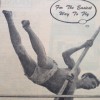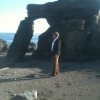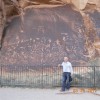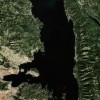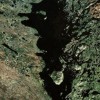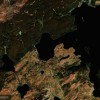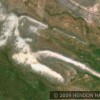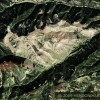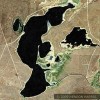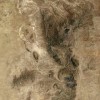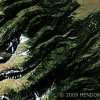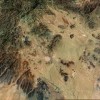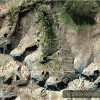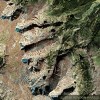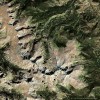
The Julius Klaproth Troll Head
Posted on Monday, May 23rd, 2011
(Click above to view image)
Location: “Lewis and Clark National Forest”, Montana
Please be tolerant of the disintegration that has occurred as this image may be over a thousand years old. As you look at the head image on the satellite photograph please note the following:
- The well shaped open mouth.
- The detail flared nostrils with a worn white bridge on the nose.
- The eye brows over each eye.
- The visible eyeball and pupil in the right elongated eye.
- Evidence that the white material used to make both eyeballs desintegrated and flowed out of the left eye like tears from the right side of the left eye.
- Puffy checks.
I am dedicating the troll head that I originally introduced on this website on April 26th, 2010 to Julius Heinrich Klaproth (1783-1835). Klaproth was a leading German orientologist or Asiatologist of his time. His grasp of languages was exceptional as was his interest in all things Asian. He published his first work in 1802 at age 19 and over his life published more than 300 books or articles before his death in 1835 at age 52. He was widely respected in his time. However he was a “generalist” in “contrast with the 21st century focus on specialization”. So although he is credited with applying scientific standards with critical methods to East Asian research he was personally controversial in several of his assertions.
- In 1812 at age 30 he published an article stating Uighur was a Turkic language that was disputed by Isaak Schmidt (a specialist in the subject).
- In 1821 at age 38 he published The Itinerary of a Chinese Traveller “and a similar series obtained from him in the London foreign office, … all regarded as spurious”.
- Donald Keene wrote about Klaproths efforts in 1834 to translate an 8th century poem. “Not surprisingly, his translation was anything but accurate”.
- However, in my opinion his most controversial assertion was made in 1831 when he declared that French sinologist Joseph de Guignes’ 1761 conclusion that Hwai Shan and four other Buddhist priests had traveled to the Americas in 458 AD false. Klaproth stated the trip was impossible because according to him the ancient Chinese lacked the equipment and the knowledge to use the equipment that was necessary to make a trip from Asia to North America.
Thanks to Joseph Needham (1900 to 1995) and several other experts we now know that the Chinese did in fact have the equipment and the skills to have made what would have actually been an easy trip from Asia to North America in the middle of the 5th century.
The reason I am questioning Klaproths credibility is because he is the first witness (the Star Witness) to discredit Joseph de Guignes’ translation and report on Hwai Shan’s trip. However, the academic world still accepts Julius Klaproth’s declarations even with evidence now available that indicates that de Guignes’ conclusions were the more accurate.
The apparent unwillingness to acknowledge the discovery of foreign artifacts and cultural influences in ancient America has to do with diffusionism and what type of diffusionism one chooses to accept.
The most commonly held belief on diffusion (or how and why almost identical culture, religion, architecture, agriculture, etc spread around the ancient world) is “evolutionary diffusionism”. The other competing viewpoint is “cultural diffusionism”. Evolutionary diffusionism believes that mankind continues to evolve culturally. Therefore, according to evolutionary diffusionism similar tools, weapons, customs, architecture, religion, etc could and have appeared at places never connected culturally around the ancient world because these were concepts whose time had come and in each society in which they appeared they arrived spontaneously and independently from the other cultures which also had these same concepts appear. The majority of the academic world share this belief.
The minority group, the cultural diffusionists believe that the explanation for the appearance of these cultural similarities is that they were manually diffused (transferred by human contact). (That is practically everything except for the most basic tools, weapons and customs etc). The cultural diffusionists do not appear to be held in high regard (or much of any regard for that matter) by evolutionary diffusionists. “There is a reason, according to the academics who uphold anthropological orthodoxy at universities and research institutes, why the diffusionists have elicited nothing but enmity or disregard for their views: they are crackpots and lunatics”. Let me see if I’ve got this right. In other words is it true that based on a philosophy can one reject or ignore inconvenient evidence that would tend to disprove a conclusion that they have previously made and hold dearly?
One commonly held belief is that the ancients didn’t travel much so cultural diffusion was therefore impossible or next to impossible. If that belief is correct then how do you explain the extent of the Chinese Han Dynasty wealth, culture and access to the Roman Empire BCE. According to reknown sinologist Homer H. Dubs in his translation of “The History of the Former Han Dynasty” Volume III by Pan Ku (page 511) when Wang Mang was killed at his palace on October 6th, 23 AD he had more gold in storage there than the total in all of Europe at that time. Everyone has heard of the Silk Road, the paths by which China traded with the Middle East and all points in between. The Silk Road was a series of land and oceanic paths that extended from Xi’an/Chang’an China (the capital of the Han Dynasty) to Roman, Italy. For those reports of Wang Mang’s wealth to be true then the 21st century apparently is not the first time that China has had trade goods that the rest of the world felt like they had to have. With ships the size needed to carry this cargo, the maps and navigation equipment necessary for these trips to be safely made does it take a leap of faith to believe that the Chinese may have taken exploratory excursions with their merchant marine and navy. With Zhang Heng & Phei Hsiu in the 1nd and 3rd century CE mapping the heavens and earth in quantitative grid map detail where would it have been impossible for them to travel using their GPS. No they didn’t have Global Positioning Satellites but they did have the next best thing-Global Positioning Stars.
This is just one example of how cultural diffusion occurred. There are other numerous examples of how cultural diffusion was accomplished by human contact throughout the ancient world. In my opinion that is how culture spread around the ancient world because the ancients were traveling extensively.
Having said this there is so much we cannot yet explain. Therefore, lets all be patient with each other as we work to discover the truth.
Pale Ink/Gods from the East
Henriette Mertz (1953)
Fusang or the Discovery of America by Chinese Buddhist Priest in the Fifth Century
Charles G. Leland (1875)
*Both books entirely available online *
Please let me know what you think of this geoglyph.
The Beak of the 10th Sun Raven STILL GLOWS!

